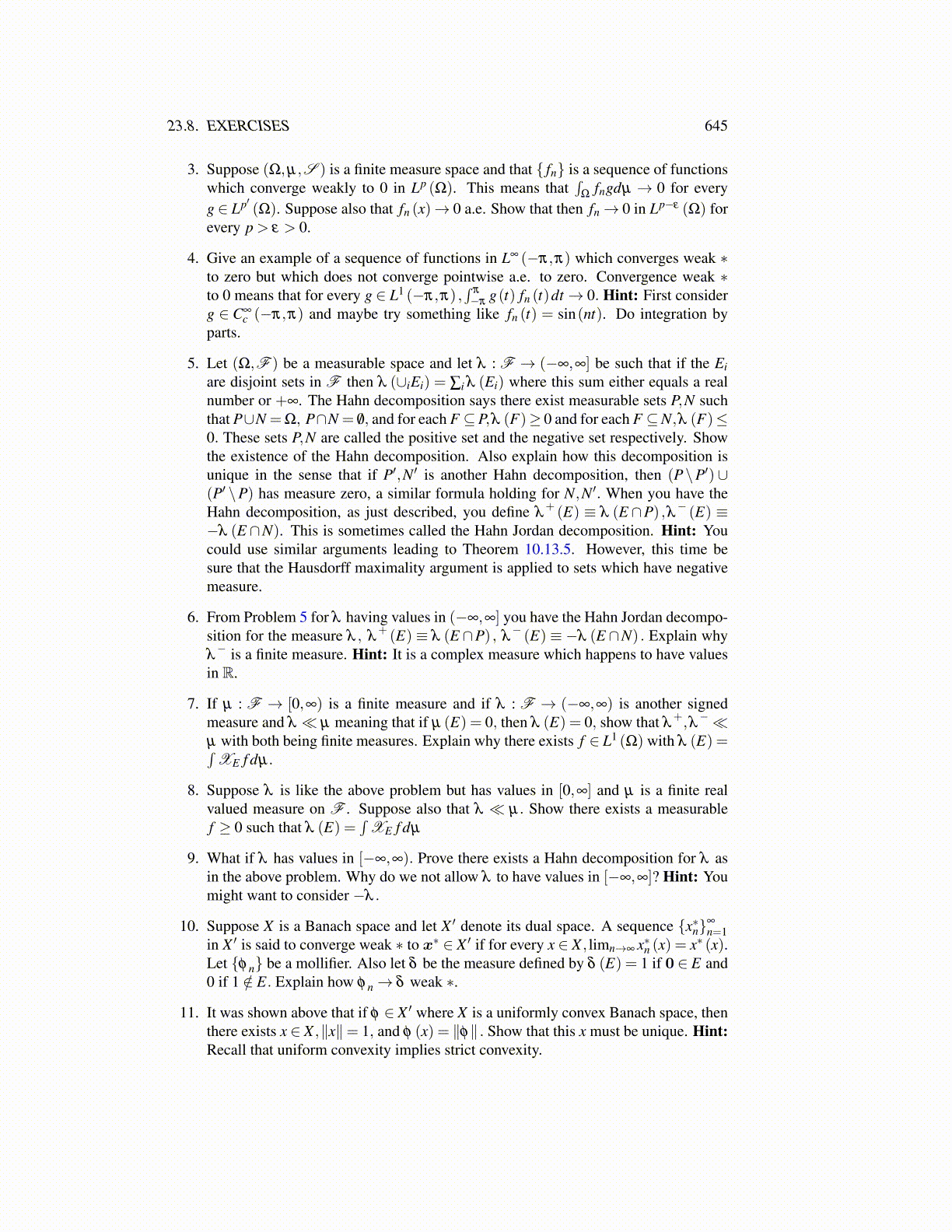
23.8. EXERCISES 645
3. Suppose (Ω,µ,S ) is a finite measure space and that { fn} is a sequence of functionswhich converge weakly to 0 in Lp (Ω). This means that
∫Ω
fngdµ → 0 for everyg ∈ Lp′ (Ω). Suppose also that fn (x)→ 0 a.e. Show that then fn→ 0 in Lp−ε (Ω) forevery p > ε > 0.
4. Give an example of a sequence of functions in L∞ (−π,π) which converges weak ∗to zero but which does not converge pointwise a.e. to zero. Convergence weak ∗to 0 means that for every g ∈ L1 (−π,π) ,
∫π
−πg(t) fn (t)dt→ 0. Hint: First consider
g ∈ C∞c (−π,π) and maybe try something like fn (t) = sin(nt). Do integration by
parts.
5. Let (Ω,F ) be a measurable space and let λ : F → (−∞,∞] be such that if the Eiare disjoint sets in F then λ (∪iEi) = ∑i λ (Ei) where this sum either equals a realnumber or +∞. The Hahn decomposition says there exist measurable sets P,N suchthat P∪N =Ω, P∩N = /0, and for each F ⊆P,λ (F)≥ 0 and for each F ⊆N,λ (F)≤0. These sets P,N are called the positive set and the negative set respectively. Showthe existence of the Hahn decomposition. Also explain how this decomposition isunique in the sense that if P′,N′ is another Hahn decomposition, then (P\P′)∪(P′ \P) has measure zero, a similar formula holding for N,N′. When you have theHahn decomposition, as just described, you define λ
+ (E) ≡ λ (E ∩P) ,λ− (E) ≡−λ (E ∩N). This is sometimes called the Hahn Jordan decomposition. Hint: Youcould use similar arguments leading to Theorem 10.13.5. However, this time besure that the Hausdorff maximality argument is applied to sets which have negativemeasure.
6. From Problem 5 for λ having values in (−∞,∞] you have the Hahn Jordan decompo-sition for the measure λ , λ
+ (E) ≡ λ (E ∩P) , λ− (E) ≡ −λ (E ∩N) . Explain why
λ− is a finite measure. Hint: It is a complex measure which happens to have values
in R.
7. If µ : F → [0,∞) is a finite measure and if λ : F → (−∞,∞) is another signedmeasure and λ ≪ µ meaning that if µ (E) = 0, then λ (E) = 0, show that λ
+,λ−≪µ with both being finite measures. Explain why there exists f ∈ L1 (Ω) with λ (E) =∫
XE f dµ .
8. Suppose λ is like the above problem but has values in [0,∞] and µ is a finite realvalued measure on F . Suppose also that λ ≪ µ. Show there exists a measurablef ≥ 0 such that λ (E) =
∫XE f dµ
9. What if λ has values in [−∞,∞). Prove there exists a Hahn decomposition for λ asin the above problem. Why do we not allow λ to have values in [−∞,∞]? Hint: Youmight want to consider −λ .
10. Suppose X is a Banach space and let X ′ denote its dual space. A sequence {x∗n}∞
n=1in X ′ is said to converge weak ∗ to x∗ ∈ X ′ if for every x ∈ X , limn→∞ x∗n (x) = x∗ (x).Let {φ n} be a mollifier. Also let δ be the measure defined by δ (E) = 1 if 0 ∈ E and0 if 1 /∈ E. Explain how φ n→ δ weak ∗.
11. It was shown above that if φ ∈ X ′ where X is a uniformly convex Banach space, thenthere exists x ∈ X ,∥x∥= 1, and φ (x) = ∥φ∥ . Show that this x must be unique. Hint:Recall that uniform convexity implies strict convexity.